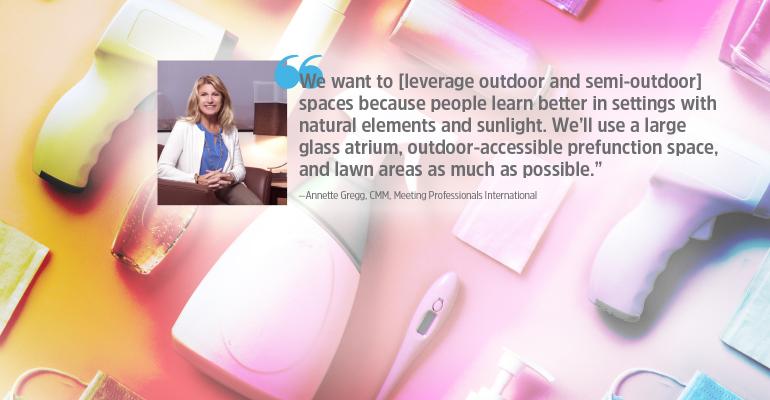The effort starts with event registration. “At our registration desks, each attendee’s ID is scanned without being handled, and then the attendee takes the badge and lanyard themselves,” says Christine Hilgert, CMP, senior vice president of independent planning firm Meeting Expectations. “There’s no contact with anyone.”
Amber Heintz, CMP-HC, vice president of program operations for independent planning firm Bishop-McCann, notes that “we are using an event’s mobile app to get administrative things done beforehand so that nobody has to touch anything on site unless necessary. We also use it to ask health-related questions, and attendees receive a personal bar code they must present upon arrival that says they have acknowledged that they feel well and have no symptoms and will abide by all our rules while on site.” (For more on developing an attendee code of conduct, see Question 4.) Combined with the other actions detailed below, these approaches enhance safety while demonstrating the host’s due diligence regarding duty of care.
As hotels and other meeting venues scramble to adapt meeting environments in the Covid-19 era, they’re getting creative about outdoor events. The result is more educational, networking, and sponsor-led sessions on decks, lawns, and even in parking lots, using tents that provide sun and weather protection as well as good air flow.
Additionally, prefunction spaces with doors or windows that open to the outside are being used to host breakout sessions through the strategic placement of planters or other partitions. “Keeping doors and windows open as much as possible is so helpful, though you still must make sure people are wearing masks and maintaining a six-foot distance, even when outside,” says Mark Herrera, director of education and life safety for the International Associiation of Venue Managers. One other element to consider: “You need to plan for physical security and information security if you use outdoor or semi-outdoor spaces.”

One meeting that used prefunction spaces for educational purposes was Meeting Professionals International’s World Education Congress, held November 3-6 in Dallas. The hybrid event had about 700 in-person attendees registered, though the planning team had prepared the indoor and outdoor space at the Gaylord Texan Resort & Convention Center to accommodate an audience as large as 1,200 on site.
Annette Gregg, CMM, senior vice president for experience at MPI, says that “we wanted to [use outdoor and semi-outdoor spaces] anyway because people learn better when settings have natural elements and sunlight. We used the Gaylord’s large glass atrium space, prefunction space with outdoor accessibility, and lawn space as much as possible.” When it comes to the opening-night outdoor concert, though, “we used stickers on the ground that say “Stand here,” because in that type of situation people tend to get close together without realizing it.”
The biggest complications, however, come with general sessions and breakouts that use traditional indoor spaces. Besides keeping attendees socially distanced throughout each session, the entry and exit process for meeting rooms makes distancing difficult to maintain—and each room must be disinfected before the next group of attendees enters the space, requiring longer breaks and more labor. But there is a way for planners to avoid that situation: Keep groups of attendees together for a series of breakout sessions, use assigned seating, and have only the presenters change rooms between sessions rather than attendees.
For a July 2020 corporate meeting of 200 employees, Christine Hilgert persuaded her client to assign each attendee an individual seat in both the ballroom and whichever breakout room hosted their session track; attendees could not choose which breakouts to attend, instead remaining in one room for every breakout session in their particular track. To maintain social distancing, “we used all the event space on property,” which was about four times more than a group that size would have used before the pandemic. “We brought in comfortable chairs with a side desk (see photo above), and each had a number on it so that each attendee had their own seat for the week.” Further, the stationary setup enabled planners to make a digital seating chart that also listed the personal and professional interests of each attendee, which let people recognize and connect with each other during socially distanced refreshment breaks.

Between breakout sessions, the facility disinfected the presenter’s table, chair, and audiovisual equipment, while all presenters had their own lavalier microphones that went with them from room to room. And at night, the facility covered electronic equipment in the meeting rooms before using a fogging agent to sterilize the space.
Food and beverage is another area where new scheduling needs to be considered. When refreshment breaks and meals happen, it will take longer for people to be served and eat. For instance, Hilgert did buffet-style meals for her corporate event, employing servers who stood behind glass partitions so that attendees touched only their plates. Of course, moving 200 attendees through the line in a socially distanced manner required a slow, deliberate process as well as more labor. “We had about three times the number of foodservice staff than in past years, even for coffee breaks,” Hilgert says. “But we negotiated the rate per server, and you can always do grab-and-go boxed items to keep costs down. Also, you might offset any cost increase because you’ll probably need much less housekeeping service—only on request.”
Lastly, with MPI having an off-site reception for all three nights of its WEC, transportation protocols needed revision. Besides socially-distanced boarding queues, “there was no more than half-capacity on each bus because there should be at least one empty seat between attendees, and masks were required,” Gregg says. For future events, depending on how quickly buses can make the round trip, more of them might not be necessary—though attendees' wait time might increase a bit.





